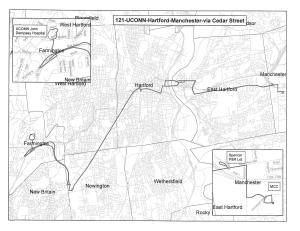The Busway to the Future: Insider to CTfastrak before Opening to Public
By Mike LaPorte
Live Wire Marketing/Advertising Director
A vibrant community is a livable community. It is what connects people to everything they need—jobs, housing, business opportunities, and health care centers—making their lives a lot better and easier. Beginning in early 2015, central Connecticut will have exactly that. CTfastrak is the state’s first Bus Rapid Transit (BRT) system, providing a state-of-the-art transit service on bus-only, traffic-free roadway. CTfastrak is a name that has been thrown around in the local news for some time recently. It has also been a huge marketing push and a lot of media attention directed at this new form of transportation, but people are not entirely sure what CTfastrak is exactly.
The idea came as a result of a study conducted by Governor John G. Rowland’s administration in 1997 which focused on solutions to traffic on Interstate 84 west of Hartford. Anyone who comes from Hartford and points west knows how much of a mess I-84 has been and will continue to be. In 2006, legal documentation and preliminary designs were completed and the plans for Connecticut’s first form of rapid transit had taken its shape.
Between 2007 and 2011, the Federal Transit Administration, a division of the United States Department of Transportation, looked at the plans and a documentation put together by the Connecticut Department of Transportation (DOT), and eventually they approved of the plans.
After Dan Malloy was elected as the Governor of Connecticut back in 2011, he announced that the plans to build what was previously known as the New Britain-Hartford Busway were going to go through the General Assembly. The House and Senate both approved the bill to fund the project with state money, and the Governor signed it, making the busway a done deal. Within the next year, officials from both the US and CT DOT joined the Governor in a ceremonial groundbreaking, commemorating the construction of what we now know as CTfastrak. In a speech Governor Malloy spoke at the ceremony, he discussed about the future of transit in Connecticut. “With the investment in bus rapid transit…we are well on our way to turning the page on years of neglect,” he said.
CTfastrak is a much cheaper alternative to light and commuter rail systems. It operates in much of the same manner as well. Every three or six minutes, a bus will arrive at a station, drop off its passengers and pick up those waiting to continue on. Buses will travel along a guide way that runs between downtown New Britain and Asylum Street in Hartford. Once the buses leave the guide way in Hartford, they will travel to the Union Station, where there will be a changeover option for rail commuters. From there they will make a loop through Downtown Hartford and utilize existing bus stops along local roads.
The stations will be located in New Britain, Newington, West Hartford and Hartford. Each one has two platforms for the eastbound traffic and the westbound traffic (except for downtown New Britain because it is the western terminus). Twelve new stations are currently being built and many are almost done. There are three bus stations located in downtown New Britain, where new buses only exit from the ramp of CT-72 and it adds on express routes west of the city as well as the Central Connecticut State University (CCSU) connector route; East Main Street and East Street. Newington has two stations located on Cedar Street, which has an exit for buses to go to Westfarms Mall and to the University of Connecticut Health Center, and the Newington Junction. West Hartford has two stations located on Elmwood, which is the eastern exit point for the CCSU connector, and on Flatbush Avenue. Hartford has the most stations located on Kane Street, Park Street, Sigourney Street (which is the last station that is directly on the guide way) and on Union Station.
CTfastrak will run alongside the Amtrak rail tracks that go between Hartford and New Haven until the two will split away from each other at the Newington Junction. A part of that rail system was abandoned and eliminated to make room for the new guide way. Also, along the parallel between the busway and the rail line is where the new Connecticut Rail Hartford Line, previously known as the New Haven-Hartford-Springfield commuter rail line, will run. “We’ve designed [the Flatbush Station] to leave room for an up-and-over between the two stations. So if you’re coming up from New Britain, you can come to Newington Junction, which is another one, or Flatbush, and just get onto that up-and-over and get to the rail services,” states CT DOT Transit Manager Lisa Rivers.

The Route that will take people from Hartford to MCC no worry. Credit to CT Department Of Transportation.
Manchester Community College students can benefit from this because MCC will be getting its own dedicated route that uses the CTfastrak guide way. Starting from MCC, the bus route goes along Silver Lane and Main Street in East Hartford. It continues into downtown Hartford, where it will enter the guide way and stop at all stations between Union Station and Cedar Street in Newington. It will then exit the guide way from those locations and proceed on to the UConn Health Center, going back to the same route to MCC. If students wish to go straight from MCC to New Britain, they can get off at one of the stations on the guide way and catch the local route that travels between Hartford and New Britain. “You won’t have to transfer if you want to get west of Hartford now. You’ll be able to stay on this bus,” Rivers explains.
According to Rivers, “opening day is coming March 28th of [2015].” More information can be found out about the project at its official website: http://www.ctfastrak.com/, on Facebook and on Twitter, @CTfastrak.


